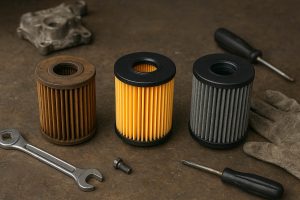From the earliest days of motoring to today’s high-tech engines, filters have played an indispensable role in protecting powertrains, improving air quality, and prolonging component life. Over time, filter technology has evolved dramatically — from rudimentary meshes and paper elements to advanced synthetic media, nanofibers, and hybrid constructions. In this article, we’ll trace that evolution, compare technologies, and explain why modern filters are superior.
If you’re shopping for an upgrade, you can also buy Filters online for your vehicle.
Early Filtration: Mesh, Cotton and Wire Screens

Origins & Challenges
-
In the earliest cars, engines often lacked any sophisticated filtration; oil suction screens or coarse wire mesh guards were all that stood between bearings and abrasive particles.
-
Some early systems used steel wool, wire mesh, or woven cloth as crude filters. These captured only larger particles but offered minimal fine filtration.
These primitive designs provided basic protection but were insufficient as engines became more powerful and tolerances tighter.
The Rise of Paper & Cellulose Filters
Why Paper?
-
In the mid-20th century, paper (cellulose) media became common because it was inexpensive, easy to pleat, and provided improved particulate trapping over mesh.
-
By the 1940s and 1950s, paper cartridge filters or replaceable paper elements began replacing older cloth or mesh filters.
-
The spin-on, self-contained oil filter (where filter + housing are replaced together) was patented and popularized in the 1950s, employing paper media.
Strengths and Limitations
-
Pros: Low cost, adequate for many stock applications, easy to produce in bulk.
-
Cons: Limited dirt-holding capacity, degradation under heat/chemical exposure, less effective at extremely fine particles, can collapse under pressure in demanding conditions.
Transition: Paper + Synthetic Blends & Improved Designs
As engines advanced, filter media had to improve. The next step was combining cellulose with synthetic fibers or improving the structure.
Hybrid / Composite Media
-
Manufacturers began blending cellulose fibers with synthetic fibers (e.g. polyester, fiberglass) to create a more robust, durable media capable of capturing finer particulates.
-
Some filters adopted depth filter designs, where the media has a gradient of pore sizes — larger pores near the surface, and finer pores deeper inside—so that coarse particles are trapped first and fines deeper later.
These evolving designs improved life, resistance to collapse, and filtering precision, bridging the gap toward fully synthetic media.
Synthetic Media: The Modern Standard
In recent decades, fully synthetic filter media have become more widespread, particularly in high-performance, long-interval, or premium filters.
What Makes Them Better?
-
Synthetic media (fiberglass, polyester, nanofibers, polymer composites) can create more tortuous paths, trap finer particles, and maintain structure under harsh conditions.
-
Greater dirt-holding capacity: They can trap more contaminants before becoming too restrictive.
-
Better resistance to heat, moisture, chemicals: Synthetic fibers don’t degrade as readily as cellulose.
-
More consistent flow characteristics and lower collapse risk under pressure.
For modern engines with tight clearances, long service intervals, and high demands, synthetic filters are often the preferred choice.
Comparative Table: Paper vs Synthetic Filters
| Feature / Parameter | Paper / Cellulose Media | Synthetic / Mixed / Advanced Media |
|---|---|---|
| Cost | Lower | Higher initial cost |
| Filtration Efficiency | Good for many applications | Higher, captures finer particles |
| Dirt Holding Capacity | Moderate | Higher |
| Structural Integrity under Pressure | Can collapse or deform | More robust, less risk of collapse |
| Resistance to heat / chemicals | Moderate | Excellent |
| Lifespan / Service Interval | Shorter | Longer |
| Consistency over life | Variable (due to clogging effect) | More stable performance |
Other Advances & Innovations
Beyond basic synthetic media, filter technology continues advancing:
-
Nanofiber layers: Ultra-fine fibers near the surface provide excellent filtration without overly restricting flow.
-
Dual-stage or multilayer filters: Combining coarse layers (for heavy particulates) and fine layers (for deeper filtration).
-
Magnetic or electrostatic elements: Some filters include magnetic strips or electrostatic charges to attract metallic particles or fine dust.
-
Modular / cartridge designs: Returning to replaceable inner modules to reduce waste and cost. Some modern OEMs shift back to serviceable cartridge media.
-
Advanced coatings & sealants: To protect media edges, resist moisture, and maintain durability.
Application: Air Filters, Fuel Filters, Cabin Filters & Beyond
While our focus often falls on oil filters, the evolution theme extends to air, fuel, and cabin filters too.
-
Air filters: Starting from paper or foam, now many high-performance air filters use cotton gauze, synthetic media, and multilayer composites (e.g. K&N uses cotton gauze media in many designs).
-
Fuel filters: Shifted from paper elements to synthetic or high-precision filter cartridges to manage finer injections and high pressures.
-
Cabin / HVAC filters: Evolved from simple panel filters to multilayer synthetic and activated-carbon media to trap gases, odors, and microscopic pollutants.
Choosing the Right Filter for Today’s Engines

When selecting filters today, especially for modern or performance engines, consider:
-
Filtration vs Flow Trade-off: The best filter balances high efficiency with acceptable pressure drop.
-
Service Interval: Synthetic media supports longer intervals if matched to oil and engine specs.
-
Application & Environment: In dusty, harsh, or high-performance environments, favor synthetic or hybrid media.
-
Compatibility: Ensure filter housing, seals, bypass/anti-drain valves match your vehicle.
-
Brand & Certification: Look for OEM or trusted aftermarket brands with performance data.
-
Maintenance & Replacement Cost: Synthetic filters cost more upfront but may last longer and protect engine better over time.
Summary & Outlook
The journey from simple wire meshes and cotton cloth to modern synthetic and nanofiber composites reflects the increasing demands we place on filters. As engines evolve — higher pressures, tighter tolerances, longer life intervals — filter media must keep pace by offering finer filtration, higher capacity, and structural resilience.
If you’re ready to upgrade your filters in line with these advancements, you can explore quality media, replacement cartridges, and high-performance options and buy Filters online to match your vehicle’s needs.
In summary:
-
Early filters were rudimentary, capturing only coarse particles.
-
Paper and cellulose filters dominated for decades as a practical, low-cost solution.
-
Over time, blends and improved designs enhanced their capabilities.
-
Today, synthetic media lead in performance, durability, and precision.
-
The future may bring even more advanced nanomaterials, smarter filters, and sustainable designs.
By understanding the evolution of filters, you can make informed choices — choosing media that protect your engine, enhance longevity, and maintain performance in all conditions.